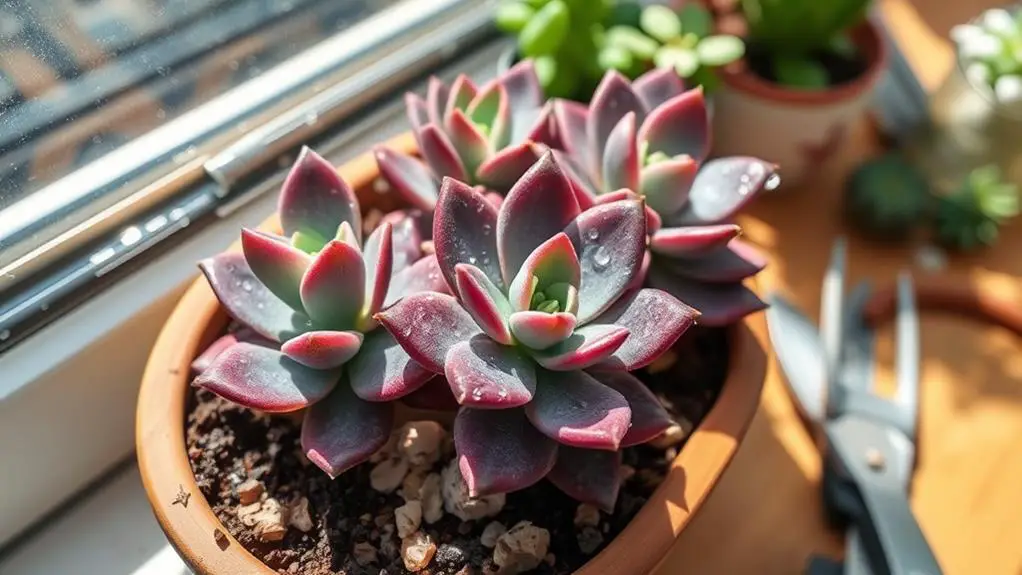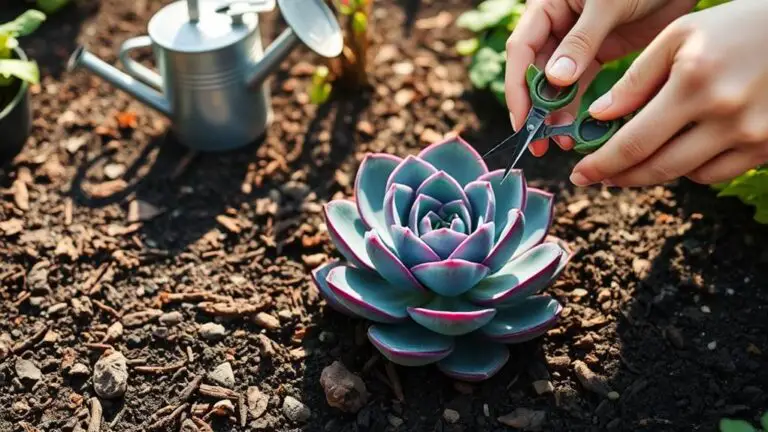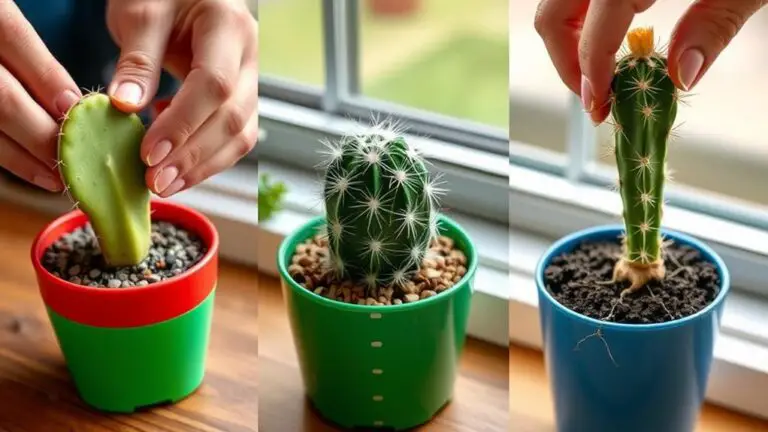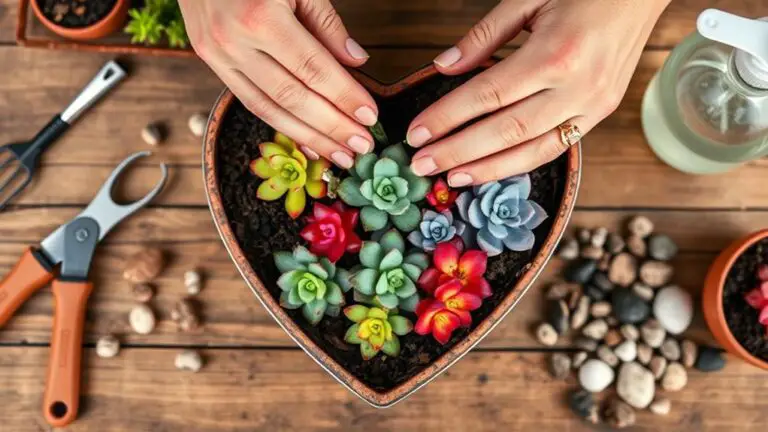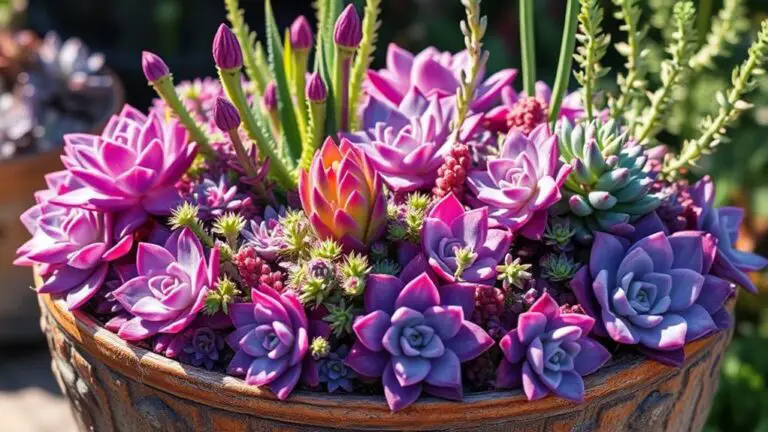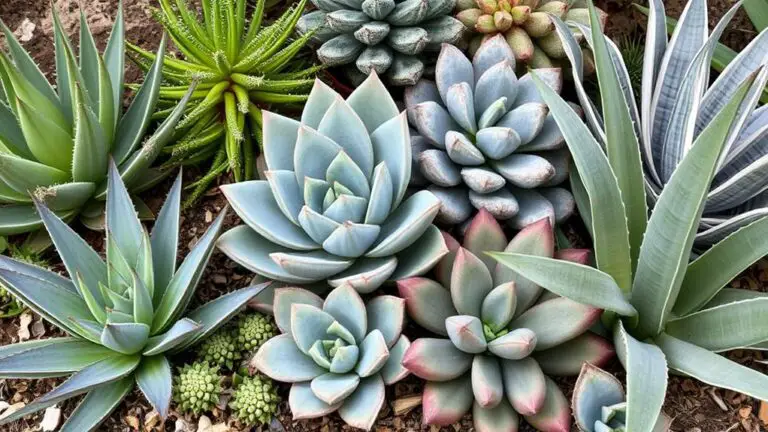5 Essential Steps to Care for Your Graptoveria Debbie
Caring for your Graptoveria Debbie doesn't have to be complicated, but it does require attention to specific details. First, you'll need to think about the light conditions; this succulent thrives with 6-8 hours of bright, indirect light, but direct sunlight can scorch its delicate leaves. Next, consider how you water it; the soak and dry method is essential here. But that's not all—there's more to understand about soil, fertilization, and pest management. Are you ready to transform your plant care routine and guarantee your Graptoveria Debbie flourishes?
Light Requirements
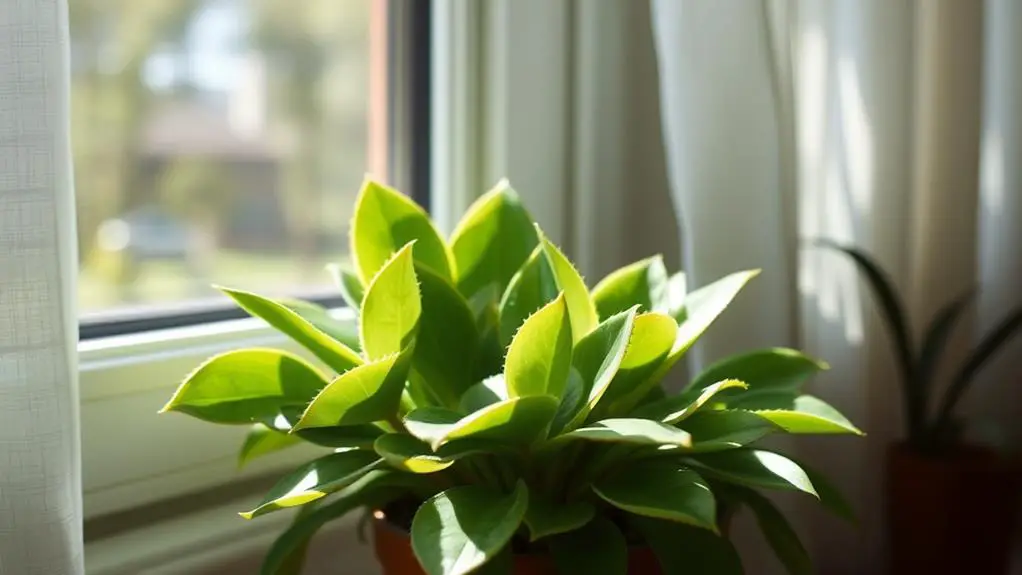
Making sure your Graptoveria Debbie thrives starts with meeting its light requirements. This succulent loves bright, indirect light, needing at least 6-8 hours of sunlight daily for ideal growth. Placing it within one foot of a south-facing window is perfect, especially if you're growing it indoors. This positioning maximizes light exposure without the risk of damaging the leaves.
If your home has low-light conditions, don't worry. You can supplement natural light with full-spectrum LED grow lights. Position these about 12-18 inches above your Graptoveria to guarantee it gets enough light. This way, you can still achieve that bright, indirect light it craves.
However, be cautious of intense direct sunlight, particularly during peak hours. Too much direct sun can cause leaf scorch, which harms your plant.
Watering Practices

While light is essential for your Graptoveria Debbie, proper watering practices are equally important to guarantee it remains healthy and vibrant.
To start, always water thoroughly but let the soil dry completely before the next watering. This method, known as the soak and dry method, helps prevent root rot. Check the top inch of soil; if it feels dry to the touch, it's time to water.
Overwatering is a common mistake. Signs include yellowing leaves and mushy stems. If you notice these, cut back on watering immediately.
On the other hand, wrinkled leaves indicate that your Graptoveria Debbie needs more water.
Make sure your pot has drainage holes to avoid standing water, which can lead to root rot.
During the growing season, usually spring and summer, your plant will need more frequent watering. However, in the winter months, reduce watering as the plant enters dormancy.
Soil and Fertilization
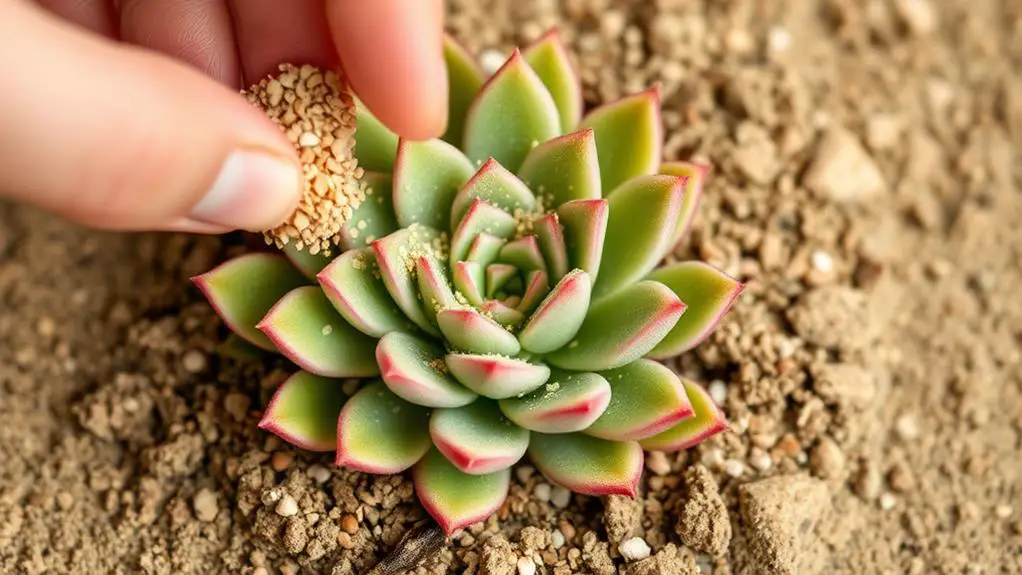
When caring for your Graptoveria Debbie, selecting the right soil mix is crucial for its health and growth. You'll want to use a well-draining soil, like a cactus or succulent mix, which helps prevent root rot.
Perlite or sand in the mix enhances drainage, keeping moisture levels just right. For ideal growth, consider a DIY mix of equal parts potting soil, perlite, and sand.
Fertilizing is also key. During the growing season in spring and summer, use a balanced, diluted liquid fertilizer, such as a 10-10-10 formula, every 4-6 weeks. This will provide the nutrients your plant needs without overwhelming it.
Keep an eye on the soil for signs of nutrient depletion and adjust your fertilizing schedule if necessary.
Repot your Graptoveria Debbie every 1-2 years to refresh the soil and guarantee it has adequate space. Choose a pot size that's about 10% larger than the previous one to accommodate growth while maintaining proper moisture levels.
This helps avoid issues like waterlogged roots and gives your plant room to thrive. With the right soil and fertilization practices, your Graptoveria Debbie will flourish beautifully!
Potting and Repotting
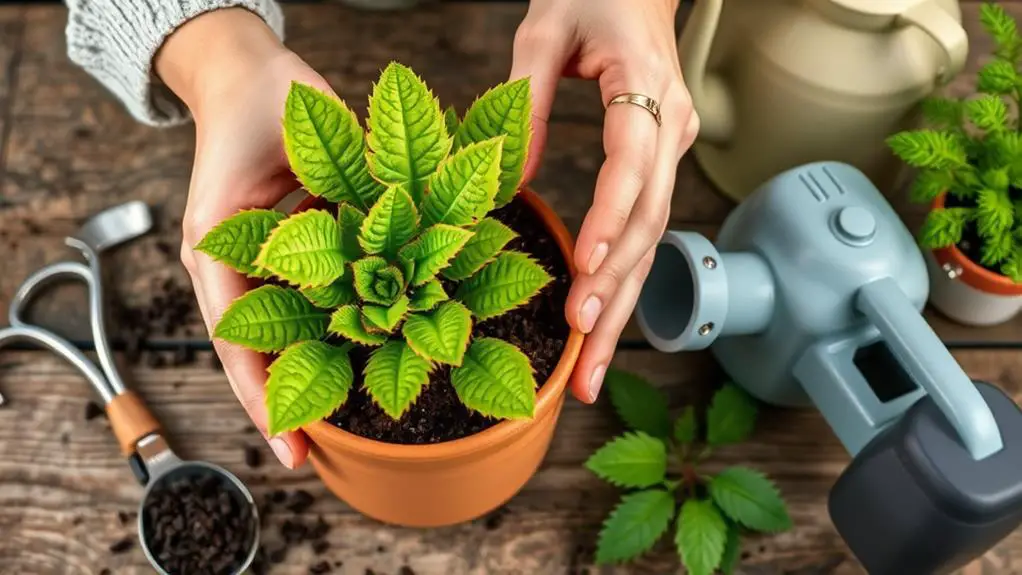
Now that you've got the soil and fertilization down, let's focus on potting and repotting your Graptoveria Debbie. Choosing the right pot and soil mix is essential to keep your plant healthy. Here's what you need to do:
- Use pots with drainage holes made of materials like terracotta, clay, or ceramic to guarantee proper drainage.
- Always use well-draining soil, such as a cactus or succulent blend, to prevent root rot.
- Repot every 1-2 years during the active growing season to refresh the soil and provide room for growth.
- Choose a new pot that's approximately 10% larger than the current one to accommodate the plant's growth without overwhelming it.
When you're ready to repot, start by gently removing the plant from its current pot.
Carefully loosen the roots and remove any dead or rotting parts. This promotes healthy growth and prevents diseases.
Place the plant in the new pot and fill it with fresh potting soil, guaranteeing it's securely positioned.
Water sparingly after repotting to help the roots settle but avoid overwatering, which can lead to root rot.
Pest Management and Common Issues
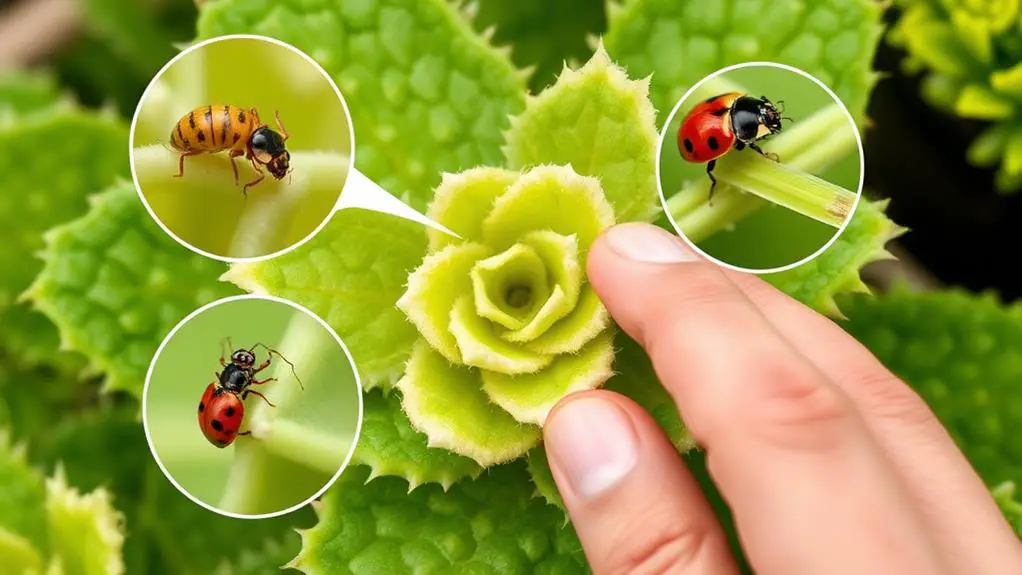
Even with careful attention, issues like pests and common plant problems can arise with Graptoveria Debbie. Regularly inspect your plant for pests such as mealybugs and spider mites. Early detection is vital for effective pest management.
Maintaining a clean environment around your plant can reduce the likelihood of infestations and promote healthy growth. If you detect pests, treat your Graptoveria Debbie with insecticidal soap or neem oil. Follow the instructions carefully to guarantee safe application.
You might notice leaf discoloration or wilting, which could be signs of pest stress. Adjusting the light exposure and checking for infestations can help restore your plant's health.
Overwatering is a common issue for succulents and can lead to root rot. To prevent this, allow the soil to dry completely between waterings.
Root rot can cause serious damage, but it's avoidable with proper watering habits.
Frequently Asked Questions
How to Take Care of Graptoveria Debbie?
Place your Graptoveria Debbie in bright, indirect sunlight for 6 hours daily. Water when the top inch of soil is dry. Use well-draining soil, repot every 1-2 years, fertilize monthly, and check for pests regularly.
How Do You Care for a Graptoveria Porcelain Plant?
You'll care for your Graptoveria Porcelain by providing bright, indirect sunlight, watering only when the soil's dry, and using well-draining soil. Keep humidity between 30-50%, temperature 65-80°F, and fertilize every 4-6 weeks. Watch for pests.
How Often Should I Water Graptoveria?
You should water your Graptoveria Debbie every 1-3 weeks, depending on environmental conditions. Always check the top inch of soil; if it's dry, water thoroughly until it drains. Adjust based on leaf appearance and season.
How to Prune Graptoveria?
To prune Graptoveria Debbie, use clean, sharp scissors to remove dead or damaged leaves at the base. Do this during the growing season. Regularly check for pests and stress, pruning affected areas, but avoid excessive pruning.
Conclusion
Caring for your Graptoveria Debbie is easy with these five steps. Give it bright, indirect light, and water only when the soil is completely dry. Use well-draining soil and fertilize every 4-6 weeks during the growing season. Check for pests regularly to keep your plant healthy. With a little attention and care, your Graptoveria Debbie will thrive and add beauty to your space. You've got this—happy gardening!

